The Cornish Pasty |
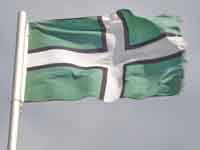
Click to see the
Hope Cove, Devon, flag flying.
The Cornish Pasty can say that Devon pasties can be every bit as good as good Cornish pasties, in fact, they have even beaten Cornish pasties in a pasty-judging competition!
This unfortunate event (for we Cornish) happened in April 2009 when Chunk of Devon won the British Pie Awards, beating Cornish pasty-producers, see HERE. Their steak pasty was voted as the winner, with their Chunki Vegetable Pasty winning Reserve Champion - that surprised the Cornish!
The British Pie Awards rules for next year in the Cornish Pasty Class have been changed and entries must now comply with the proposed European (PGI - Protected Geographical Indicator) specification for a Cornish Pasty (which must be made in Cornwall) thereby ruling out the entry of pasties made in Devon although there is another class where they can be entered - "Other Pasty". I imagine there might be lobbying to introduce a Devon Pasty Class next?
It is said that the Devon Pasty has the famous top-crimp, however, Pengenna Pasties, St Ives, uses the top-crimp and you can't get more "Cornish" than St. Ives! Perhaps the whole argument based on the position of the crust is a fallacy - Ann Muller, who makes excellent pasties on The Lizard, Cornwall, doesn't use a precise side-crimp? This can be seen here, on the same news item.
Being Cornish (for my first 20 years) and having lived in Plymouth, Devon, for over 43 years (written 2010), I have only recently taken an interest in the Devon Pasty per se - I have seen them and eaten them over those 40-odd years but they never registered with me as being different because to me a good pasty is a good pasty and you don't walk into a Devon shop and ask for a Cornish pasty!
Of course, you can get good and not-so-good in all things, Cornish and Devonian. I suppose that being such close neighbours and with a lot of cross-border exchange over the centuries it does help to blur distinctions between the two counties. In fact, it could be argued that tin-mining, and pasties, started on Dartmoor? Pasties are very much associated with tin-mining - especially for the safety reasons of the crust (to be discarded). It was discarded to avoid poisoning from dirt on the miners' hands by the heavy metals, e.g. arsenic, associated with the tin. The early Dartmoor tin working started on the surface, with alluvial streaming for tin, gradually digging into the ground to follow the mineral veins into the ubiquitous "gerts" on the moor (these are long, open trenches left by the early open-cast mining). I was never aware of these to any great extent in Cornwall. The deep mines, that are all over Cornwall, came later when the technology associated with the steam engine became available. It was probably after this that many more people were involved in tin mining in Cornwall and that the pasty became more important as a working miner's meal - this would have been when the Cornish pasty really became an everyday item in Cornish culture.
The famous Plymouth-based Ivor Dewdney business advertises their pasties as "Cornish" and follow the side-crimping style although they are not "curly-crimped .....

An Ivor Dewdney® pasty, a famous Plymouth pasty name
with a side crust, not a top crimp, but not a curly crimp!
 |
Ivor Dewdney - The same pasty as shown above but with its trademark "Ivor Dewdney®" bag. |
Here is the first proper Devon pasty that I found - here in Plymouth! It was just a baby one, on offer at a buffet!
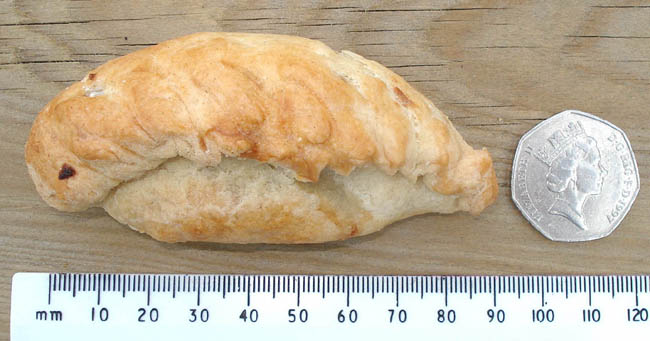
Here's a bigger one, although not "curly-crimped" .....
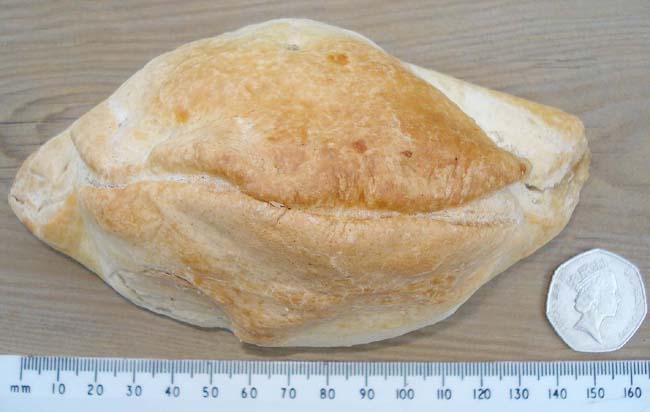
This pasty was bought in Ashburton - 6 inches / 150 mm long
- this style of Devon top crimp is well shown.
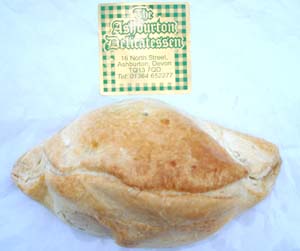 |
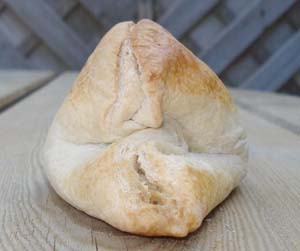 |
| The pasty with its bag from The Ashburton Delicatessen. |
End view of the the pasty from The Ashburton Delicatessen. |
And, here is the full-size Proper Devon Pasty, from Jennycliff Cafe, formerly they came from "The Pastymaker ...." at Oreston but now relocated to Jennycliff ..... sadly, they have now closed.

The Proper Devon Pasty, with the top crimp.
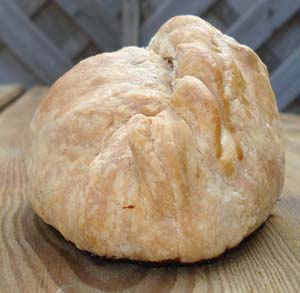 |
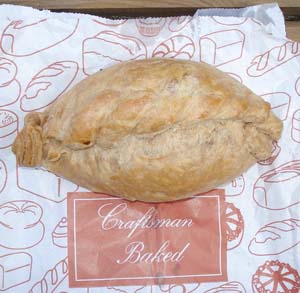 |
| Proper Devon Pasty from Jennycliff Cafe end view to show the Devon-style top crimp. |
Jennycliff Cafe Pasty with its paper bag. |
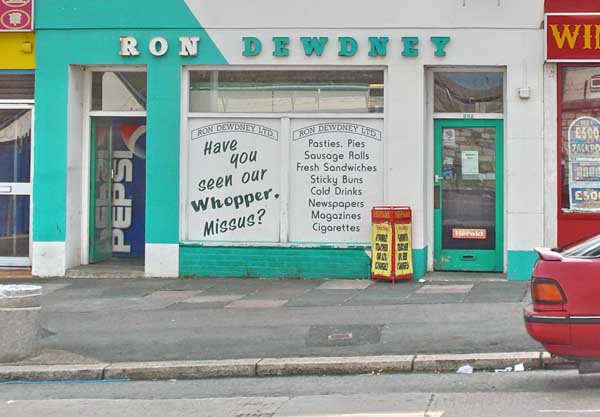
Ron Dewdney's shop opposite the St Levan Gate into Devonport Dockyard
at 202 Keyham Road, Plymouth.
NB. The Ron Dewdney shop is now owned by Ivor
Dewdney (informed by email 28th Jan. 2016).
Ron's shop echoes the history of Plymouth and of the Royal Navy in Plymouth in that it takes the place of the original 'oggie man' ("beneath the dockyard wall") - see here for that story: The Oggie Man !!! The only difference perhaps was that the original 'oggie man' in the song was outside the Albert gate. By the way, the "Whopper" seen advertised on the shop window can be seen on this web site on the Giant pasties page.
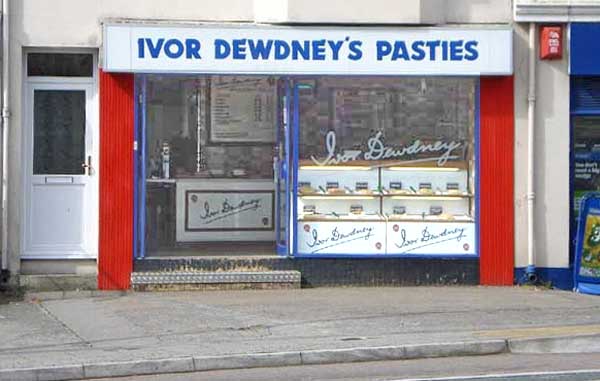
Ivor Dewdney's shop at 109 Wolseley Road, Plymouth. There are other Ivor Dewdney shops at 42 Devonport Road and 99 Cornwall Street in the centre of Plymouth.
Answers.com - Pasty offers the following .....
"In November 2006 a Devonian historian claimed that pasties originate from the other side of the river in Devon. Dr Todd Gray, chairman of the Friends of Devon's Archives, insisted he was right. 'The pasty is a Devonian delicacy and Cornwall stole it'.
His claim is based on the historic Old Audit Book and Receivers Accounts for the Borough of Plymouth, which dates back to the 16th century. The book is housed in the Plymouth and West Devon Record Office.
Dr Gray spotted four key lines of text which refer to the financial cost of making a pasty, using venison from the Mount Edgcumbe (so at least the meat was Cornish) estate just across the Tamar River. The words date back to 1510. So Dr Gray contacted the Cornwall Record Office and found that its earliest record of a pasty recipe was in 1746. Thus Devon wins the pasty war by a clear 200 years, he concluded. 'This is one of Plymouth's ancient 16th-century documents which has never been properly presented to the public. This is a great joy for me as an historian uncovering local history,' he said."
This was also reported by the BBC and the Guardian, Observer & Independent newspapers.
The full story about the entry in the entry in the Borough of Plymouth Audit Book can be seen on this web site here: The Plymouth Pasty, 1510 AD, where the whole page from the Audit Book is seen, complete with a full transcription into Modern English.
So, this was a venison pasty, as used throughout England from the Middle Ages, from at least 1380. These were mentioned by .....
Recent travels (14 March 2010) to me to Hope Cove, south of Plymouth along the Devon coast. The stores and Post Office there are proud of their pasties and after having one, I believe rightly so.

Hope Cove Post Office & Stores.
 |
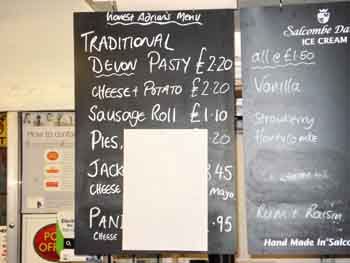 |
|
Sign above the door of Hope Cove Post Office & Stores. |
Hope Cove menu showing "Traditional Devon Pasty". |
 |
 |
|
Traditional Devon Pasty in its wrapper ..... |
..... and after final baking. |
This Devon pasty is indistinguishable from a Cornish pasty!
Other Devon pasty links
The Original Pasty House, Tavistock (web site under construction), see also here, here and here
Devon Steak & Potato Pasty, Honiton - gluten free, range of pasty and other bakery products, available online
Sweetlands, Colyton - Boveys Down Farm, organic and non-GM pasties: Express & Echo newspaper article
Once again, we endeavour to bring you the facts on The Cornish Pasty.
